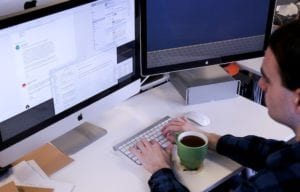 How much time do you get each day to spend thinking vs. doing, proacting vs. reacting and innovating versus executing?
How much time do you get each day to spend thinking vs. doing, proacting vs. reacting and innovating versus executing?
Probably not as much as you’d like. Most people would like to find a way to increase their overall results but also get back some quality time in their work lives.
Living your life inside “the blur”
The “Blur” is what I’m calling our professional space inside this work-a-day world.
We jump on the treadmill in the morning and it keeps on moving until the day is over. Like the poem above says, streaks of color and (sometimes) nothing more. It can feel like a blur.
 Your days are moving faster and faster too. Part of that is due your natural aging process. Each year you live the “faster” life moves. It’s a mathematical formula at work. Each year is a smaller part of the years that you have already lived therefore it moves “faster.” Or so it seems to.
Your days are moving faster and faster too. Part of that is due your natural aging process. Each year you live the “faster” life moves. It’s a mathematical formula at work. Each year is a smaller part of the years that you have already lived therefore it moves “faster.” Or so it seems to.
More blur. Life can pass you by before you know it.
As I reflect on the “typical” day of a 21st Century Marketer, it’s easy to see why one can become a victim of blur or “blurnout.”
There are several things at work…
- Technology allows us to conduct work 24/7. And some of you are actually doing that!
- Marketing creative software (from web creation, email, and graphic design) has been simplified to create content easier and faster. That means the manager or staff, can now do everything themselves…and they do!
- Information is now accessible from anywhere at any time. That means if you want to know how a program is performing, you can find out, immediately. And you do!
This is life in the blur. And it’s not necessarily a path to success.
Stop the blur, I want to get off!
 Getting outside the “blur” is important for marketers. Creating great marketing ideas typically doesn’t happen while you are juggling five activities at once. The typical marketer today is writing content for a blog, checking social media for status, reviewing the web traffic numbers, creating designs and promotions and even talking to customers. This leaves precious time for coming up with that killer campaign idea. Or, the next great new product.
Getting outside the “blur” is important for marketers. Creating great marketing ideas typically doesn’t happen while you are juggling five activities at once. The typical marketer today is writing content for a blog, checking social media for status, reviewing the web traffic numbers, creating designs and promotions and even talking to customers. This leaves precious time for coming up with that killer campaign idea. Or, the next great new product.
Staying in the blur is not the recipe for success.
In a recent article by Lindsey Elias, The Importance of Downtime, she outlined three recent studies identifying the importance of downtime.
- A 2011 study from the University of Illinois at Urbana-Champaign helped put a decades-old theory to rest when it proved that even brief diversions from tasks can drastically improve a person’s ability to focus on the job at hand for prolonged periods of time.
- A Harvard Business Review article discussing research led by Sophie Ellwood details a scenario where undergraduate psychology students were broken into groups to complete a common task. It was found that the group which had been given a break to work on an unrelated task during the activity was also the one that generated the most ideas.
- A Study from the University of British Columbia shows that “our brains are much more active when we daydream than previously thought. Activity in numerous brain regions increases when our minds wander, according to new research. Psychologists found that brain areas associated with complex problem-solving—previously thought to go dormant when we daydream—are in fact highly active during these episodes.”
How to be more productive with more downtime
Rosalie Puiman writes in the Huffington Post that there is not just one sort of downtime, there are at least three types, and we need all of them.
- The first is sleep. Solid, good quality sleep gives your brain the possibility to revive itself and the body. It’s an opportunity to incorporate everything you’ve experienced during the day.
- The second sort of downtime is a vacation. A longer period (at least three to five days) of being away from work is a great way to revitalize. By being away from your normal routine, you get the chance to look at your life from a different perspective.
- The third form of downtime is both the smallest and the hardest. It’s those little nuggets of emptiness in your head that come from meditation, a nature walk, playing sports or just enjoying a cappuccino on a terrace in the middle of your working day.
They sound easy enough, as they are relatively short, but the challenge is in the continuity. Our brain needs this type of downtime several times during the day. Tony Schwartz of The Energy Project proposes to have a break after every 90 minutes of work to be optimally productive.

Don’t be afraid to ask for help
If you are finding that you simply don’t have enough time in your day take a very hard look at what you are doing. Can somebody else do it for you? Can you outsource certain projects to a qualified agency for some relief?
You really do your best and most original thinking between the blurs. You owe it to yourself to find some extra time in the day!

